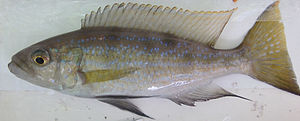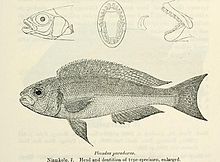Perissodus
| Perissodus | ||||||||||||
|---|---|---|---|---|---|---|---|---|---|---|---|---|

|
||||||||||||
| Systematics | ||||||||||||
|
||||||||||||
| Scientific name | ||||||||||||
| Perissodus | ||||||||||||
| Boulenger , 1898 |
Perissodus ( Gr .: perissos = uneven + odous = tooth) is a genus of African cichlids (Cichlidae), which is endemic to the East African Lake Tanganyika with two (or six) species. The type species Perissodus microlepis lives near the coast in shallow water, Perissodus eccentricus in the southern half of the lake at depths of 60 to 100 meters. They are specialized scale eaters.
features
Perissodus species reach lengths of 11 to 16 cm (30 cm if the Plecodus species are included). Your body is severely flattened on the sides. The main difference to other species of cichlids is the dentition. Perissodus species have only one row of teeth with very large, pickaxe-like teeth embedded deep in the gums with a leaf-shaped crown bent backwards with which they can reach under the scales of the victims. The pharyngeal teeth are small and pointed. The number of gill rakes is 18 to 26.
- Fins formula : Dorsal XVII – XIX / 11–13, Anale III / 8–10.
- Scale formula : 64-79.
Way of life
Perissodus species are scale eaters and feed on the nutrient-poor scales of other fish species, which they gnaw off the sides of their bodies. In adaptation to this diet, their mouth is asymmetrical and their teeth are bent and flattened in a hook-shaped manner. They sneak up on large-scale fish from behind, always from the same side, and suddenly press their wide-open mouth against one side of the body so that the hook-shaped teeth can slide under some scales and pry them out. Perissodus species themselves have very small scales (namely Perissodus “microlepis” , derived from the Greek micro “small”, and lepos “scale”), probably to protect themselves from attacks by their fellow species in this way. They are monogamous mouth brooders and seek to reproduce near the shore. A clutch contains up to 300 eggs and is therefore extraordinarily large for mouthbrooders. The larvae only have small yolk sacs and the young fish spend more time looking for food in the water than in their parents' mouths immediately after swimming free.
Systematics
The genus Perissodus was introduced in 1898 by the Belgian-British ichthyologist George Albert Boulenger . In 1976 the genus Plecodus , also first described by Boulenger in 1898 and also scaly- eating , was synonymous with Perissodus . However, the Belgian ichthyologist Max Poll separated the two genera again. Investigations based on molecular biology show, however, that both genera are closely intertwined. Plecodus is paraphyletic in relation to Perissodus and Perissodus is paraphyletic in relation to Plecodus paradoxus and Plecodus straeleni . The following cladogram illustrates the family relationships :
|
|
|
||||||||||||||||||||||||||||||
|
|
The FishBase online database and other sources continue to run Plecodus as a separate genre.
literature
- Pierre Brichard: The Big Book of Tanganyika Cichlids. With all the other fish on Lake Tanganyika. Bede Verlag, 1995, ISBN 978-3927997943 , pp. 274, 394 - 395.
- Søren Neergaard: Tanganyika - Cichlids . Kernen Verlag, 1982, ISBN 3-8740-1005-8 .
Individual evidence
- ↑ Brichard, pp. 275, 394-395.
- ↑ Brichard, page 275th
- ↑ Georg Zurlo: Perissodus. In: Claus Schaefer, Torsten Schröer (Hrsg.): The large lexicon of aquaristics. 2 volumes. Eugen Ulmer, Stuttgart 2004, ISBN 3-8001-7497-9 , p. 761 f .; here: p. 762.
- ↑ Liem, KF & DJ Stewart (1976): Evolution of the scale-eating cichlid fishes of Lake Tanganyika: a generic revision with a description of a new species. Bulletin of the Museum of Comparative Zoology v. 147 (no. 7): 319-350, pls. 1-2.
- ^ Max Poll: Classification des Cichlidae du lac Tanganyika, Tribus, genres et espèces. Acad R Belg Mém Cl Sci 1986, 45 (2): 1-163.
- ↑ Rieko Takahashi, Kitashirakawa-Oiwake, Katsutoshi Watanabe, Mutsumi Nishida & Michio Hori: Evolution of feeding specialization in Tanganyikan scale-eating cichlids: a molecular phylogenetic approach. BMC Evolutionary Biology 20077: 195, DOI: 10.1186 / 1471-2148-7-195
- ↑ Plecodus on Fishbase.org (English)
Web links
- Perissodus on Fishbase.org (English)
